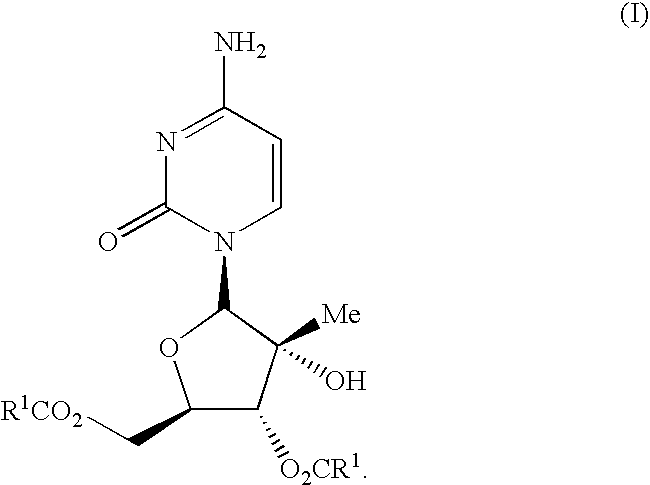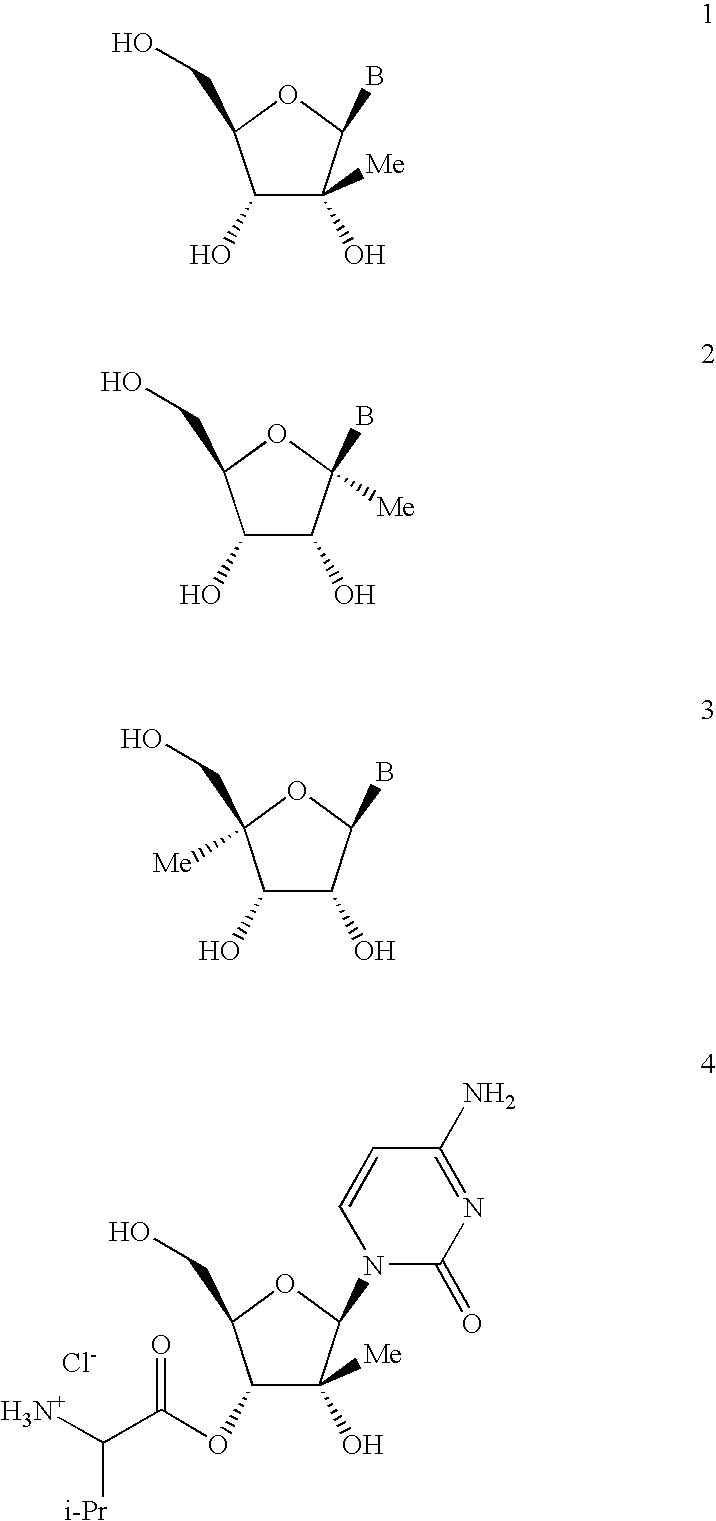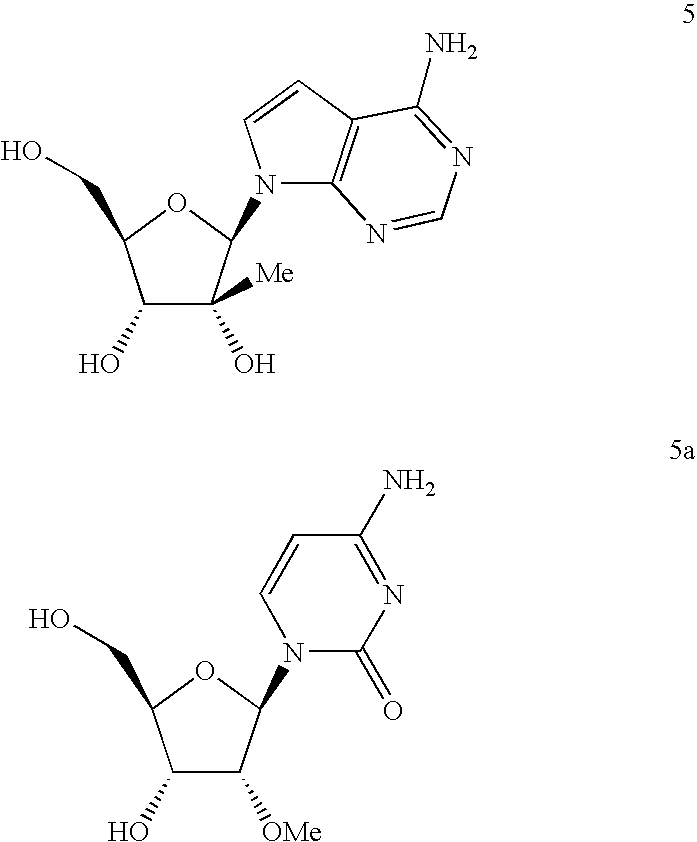Antiviral nucleosides
a technology of diacylated nucleosides and antiviral nucleosides, which is applied in the field of diacylated nucleosides 3′, 5′, and can solve the problems of limited clinical benefit, ribavirin also exhibits significant toxicity, and is known to induce anemia, and the effect of ifn is temporary
- Summary
- Abstract
- Description
- Claims
- Application Information
AI Technical Summary
Problems solved by technology
Method used
Image
Examples
example 1
Propionic Acid (2R,3R,4R,5R)-5-(4-amino-2-oxo-2H-pyrimidin-1-yl)-4-hydroxy-4-methyl-3-propionyloxy-tetrahydro-furan-2-ylmethyl ester; Hydrochloride Salt (I-1)
[0104]To a solution of I-4 (1.0 g, 3.89 mmol) in THF (15 mL) and H2O (7 mL) was added TEA (4.72 g, 33.87 mol) and the reaction mixture was cooled to 5° C. Propionyl chloride (1.44 g, 15.45 mmol) was added slowly while maintaining the temperature of the reaction mixture below 0° C. The reaction was monitored by hplc and after the initial addition was complete monopropionate ester was still present and additional propionyl chloride (0.72 g, 7.77 mmol) was added and the reaction stirred overnight at RT. The reaction mixture was cooled to 0° C. and the pH was adjusted to ca. 6.5 with con HCl. The mixture was partitioned between EtOAc (30 mL) and H2O (15 mL) and the phases separated. The aqueous phase was extracted with EtOAc (2×25 mL) and the combined organic extracts were washed with dilute brine (2×20 mL), dried (Na2SO4), filtere...
example 2
Iso-butyric Acid (2R,3R,4R,5R)-5-(4-amino-2-oxo-2H-pyrimidin-1-yl)-4-hydroxy-3-isobutyryloxy-4-methyl-tetrahydro-furan-2-ylmethyl ester; Hydrochloride Salt (I-2)
[0105]To a solution of I-4 (0.50 g, 1.94 mmol), DMAP (0.026 g, 0.21 mmol), THF (8 mL) and H2O (4 mL) was added TEA (2.36 g, 16.93 mmol) and the reaction mixture was cooled to ca. −5° C. Iso-butyryl chloride (0.93 mL, 8.75 mmol) was added dropwise ant a rate which allowed the reaction temperature to be maintained below 0° C. The reaction was monitored by HPLC-MS. Additional aliquots of 0.41 g and 0.21 g of iso-butyryl chloride (total of 1.55 g, 14.58 mmol) were added to eliminate monoacylated byproduct (determined by hplc). The reaction was stirred overnight at RT, cooled to 0° C. and the pH was adjusted to pH 6.5 with con HCl. The mixture was partitioned between EtOAc (30 mL) and H2O (15 mL) and the phases separated. The aqueous phase was extracted with EtOAc (2×15 mL) and the combined organic extracts were washed sequential...
example 3
Pentanoic Acid (2R,3R,4R,5R)-5-(4-amino-2-oxo-2H-pyrimidin-1-yl)-4-hydroxy-4-methyl-3-pentanoyloxy-tetrahydro-furan-2-ylmethyl ester; Hydrochloride Salt (I-3)
[0106]To a solution of I-4 (0.490 g, 1.90 mmol), DMAP (0.026 g, 0.21 mmol), THF (7 mL) and H2O (3 mL) was added TEA (2.31 g, 16.59 mmol) and the reaction mixture was cooled to ca. 0° C. Valeric anhydride (1.6 g, 2.57 mmol) was added dropwise at a rate which allowed the reaction temperature to be maintained below 5° C. The reaction was monitored by HPLC-MS. Two 0.32 g aliquots of valeric anhydride (2.24 g, 11.99 mmol total) were added to eliminate monoacylated byproduct. The reaction mixture was cooled to 0° C. and the pH was adjusted to pH 6.8 with con HCl. The mixture was partitioned between EtOAc (30 mL) and H2O (15 mL) and the phases separated. The aqueous phase was extracted with EtOAc (2×15 mL) and the combined organic extracts were washed sequentially with dilute NaHCO3 (2×20 mL) and water (1×20 mL), dried (Na2SO4), filte...
PUM
| Property | Measurement | Unit |
|---|---|---|
| temperature | aaaaa | aaaaa |
| temperature | aaaaa | aaaaa |
| temperature | aaaaa | aaaaa |
Abstract
Description
Claims
Application Information
 Login to View More
Login to View More - R&D
- Intellectual Property
- Life Sciences
- Materials
- Tech Scout
- Unparalleled Data Quality
- Higher Quality Content
- 60% Fewer Hallucinations
Browse by: Latest US Patents, China's latest patents, Technical Efficacy Thesaurus, Application Domain, Technology Topic, Popular Technical Reports.
© 2025 PatSnap. All rights reserved.Legal|Privacy policy|Modern Slavery Act Transparency Statement|Sitemap|About US| Contact US: help@patsnap.com



